| Admissions | Aircraft | Aviation World | Ambassadors | Accreditation | A to Z Degree Fields | Books | Calendar | Catalog | Colleges | Contact Us | Continents/States | Construction | Contracts | Distance Education | Emergency | Emergency Medicine | Examinations | English Editing Service | Economy and budget | Forms | Faculty | Governor | Grants | Hostels | Honorary Doctorate degree | Human Services | Human Resources | Internet | Investment | Internship | Login | Lecture | Librarians | Languages | Manufacturing | Money transfer(Pay Now) | Membership | Observers | Profile | Public Health | Publication | Professional Examinations | Programs | Progress Report | Recommendations | Ration food and supplies | Research Grants | Researchers | Students login | School | Search | Software | Seminar | Study Center/Centre | Sponsorship | Tutoring | Thesis | Universities | Work counseling |
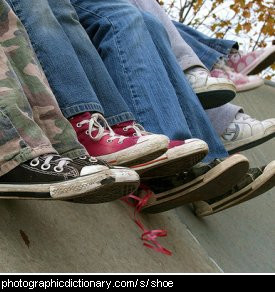 Footwear can be defined as garments that are worn on the feet. There main purpose is protecting one's feet. Of late, footwear has become an important component of fashion accessories. Although, their basic purpose remains that of protection, adornment or defining style statement has become their additional and a significant function. There are many types of footwear- shoes, boots, sandals, slippers etc. They are further categorized into many more types.
Footwear can be defined as garments that are worn on the feet. There main purpose is protecting one's feet. Of late, footwear has become an important component of fashion accessories. Although, their basic purpose remains that of protection, adornment or defining style statement has become their additional and a significant function. There are many types of footwear- shoes, boots, sandals, slippers etc. They are further categorized into many more types.Shoes and Shoe making 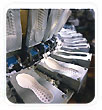 Shoes are further divided into many categories such as athletic shoes also known as
sneakers,
galoshes, high heels, Stiletto heels, kitten heels, lace-up shoes, high-Tops, loafers, Mary Janes,
platform shoes, school shoes and many others. Shoemaking can be considered a traditional handicraft
profession. However, now it has been largely taken over by industrial manufacture of footwear.
A variety of materials are used for making shoes- leather
fabrics, plastic, rubber, fabrics, wood, jute
fabrics, and metal. More than 200 operations are required for making a pair of shoes. However,
with the development of modern machines, a pair of shoes can be made in very less time as each step in
its manufacturing is generally performed by a separate footwear making machine.
Shoes are further divided into many categories such as athletic shoes also known as
sneakers,
galoshes, high heels, Stiletto heels, kitten heels, lace-up shoes, high-Tops, loafers, Mary Janes,
platform shoes, school shoes and many others. Shoemaking can be considered a traditional handicraft
profession. However, now it has been largely taken over by industrial manufacture of footwear.
A variety of materials are used for making shoes- leather
fabrics, plastic, rubber, fabrics, wood, jute
fabrics, and metal. More than 200 operations are required for making a pair of shoes. However,
with the development of modern machines, a pair of shoes can be made in very less time as each step in
its manufacturing is generally performed by a separate footwear making machine.
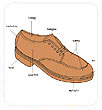 Parts of a Shoe A shoe consists of sole, insole, outsole, midsole, heel, and vamp (upper). They are the basic parts of a shoe that are mostly included in all types off shoes. Other parts of a shoe are lining, tongue, quarter, welt and backstay. These parts are included as per the design of the shoes. Sole: The exterior bottom part of a shoe is the sole. Insole: The interior bottom of a shoe, which sits directly beneath the foot, is its insole. They can be removable and replaceable too. In some of the shoes, extra insoles are often added for comfort, health or other reasons, such as to control the shape, moisture, or smell of the shoe. Outsole: It is that layer of the shoe that is in direct contact with the ground. These can be made of various materials like leather, natural or synthetic rubber etc. Often the heel of the sole is made from rubber for durability and traction and the front is made of leather for style. Special purpose shoes often have refined modifications, for example, athletic cleats have spikes embedded in the outsole to grip the ground, dance shoes have much softer or harder soles. Midsole: The layer that lies between the outsole and the insole for shock absorption, is the midsole. Some special shoes, like running shoes have other materials for shock absorption, that usually lie beneath the heel where one puts the most pressure down. Materials used for midsoles depend on the shoe manufacturers. Some shoes can be made even without a midsole. Heel: The rear part at the bottom of a shoe is the heel. It supports the heels of the feet. Heels of a shoe are often made from the same material as the sole of the shoe. It can be high for fashion purpose or for making a person look taller. They are also flat for comfort and practical use. Vamp, or upper: The upper part of a shoe that helps in holding the shoe onto the foot is the vamp or simply called the upper. This part is often embellished or given different styles to make shoes attractive. Shoe Making Process A footwear company has mainly four departments in which a progressive route is followed for producing finished shoes. These are- Clicking or Cutting Department, Closing or Machining Department, Lasting & Making Department, Finishing Department and the Shoe Room. Clicking or Cutting Department 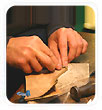 In this department, the top part of the shoe or the "upper" is made. The clicking operative is given
skins of leather, mostly cow leather but not restricted to this type of leather. Using metal strip
knives, the worker cuts out pieces of various shapes that will take the form of "uppers". This
operation needs a high level of skill as the expensive leather has to be wasted at the minimum level
possible. Leather may also have various defects on the surface such as barbed wire scratches which
needs to be avoided, so that they are not used for the uppers.
In this department, the top part of the shoe or the "upper" is made. The clicking operative is given
skins of leather, mostly cow leather but not restricted to this type of leather. Using metal strip
knives, the worker cuts out pieces of various shapes that will take the form of "uppers". This
operation needs a high level of skill as the expensive leather has to be wasted at the minimum level
possible. Leather may also have various defects on the surface such as barbed wire scratches which
needs to be avoided, so that they are not used for the uppers.Closing or Machining Department 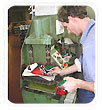 Here the component pieces are sewn together by highly skilled machinists so as to produce the completed upper.
The work is divided in stages. In early stages, the pieces are sewn together on the flat machine. In the
later stages, when the upper is no longer flat and has become three-dimensional, the machine called post
machine is used. The sewing surface of the machine is elevated on a post to enable the operative to sew
the three dimensional upper. Various edge treatments are also done onto the leather for giving an attractive
look to the finished upper. At this stage only, the eyelets are also inserted in order to accommodate the
laces in the finished shoes.
Here the component pieces are sewn together by highly skilled machinists so as to produce the completed upper.
The work is divided in stages. In early stages, the pieces are sewn together on the flat machine. In the
later stages, when the upper is no longer flat and has become three-dimensional, the machine called post
machine is used. The sewing surface of the machine is elevated on a post to enable the operative to sew
the three dimensional upper. Various edge treatments are also done onto the leather for giving an attractive
look to the finished upper. At this stage only, the eyelets are also inserted in order to accommodate the
laces in the finished shoes.Lasting & Making Department 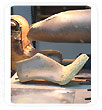 The completed uppers are molded into a shape of foot with the help of a "Last". Last is a plastic shape
that simulates the foot shape. It is later removed from the finished shoe to be used further in making
other shoes. Firstly, an insole to the bottom of the last is attached. It is only a temporary attachment.
Sometimes, mostly when welted shoes are manufactured, the insole has a rib attached to its under edge.
The upper is stretched and molded over the last and attached to the insole rib. After the procedure
completes, a "lasted shoe" is obtained. Now, the welt- a strip of leather or plastic- is sewn onto the
shoe through the rib. The upper and all the surplus material is trimmed off the seam. The sole is then
attached to the welt and both are stitched together. The heel is then attached which completes the "making" of the shoe.
The completed uppers are molded into a shape of foot with the help of a "Last". Last is a plastic shape
that simulates the foot shape. It is later removed from the finished shoe to be used further in making
other shoes. Firstly, an insole to the bottom of the last is attached. It is only a temporary attachment.
Sometimes, mostly when welted shoes are manufactured, the insole has a rib attached to its under edge.
The upper is stretched and molded over the last and attached to the insole rib. After the procedure
completes, a "lasted shoe" is obtained. Now, the welt- a strip of leather or plastic- is sewn onto the
shoe through the rib. The upper and all the surplus material is trimmed off the seam. The sole is then
attached to the welt and both are stitched together. The heel is then attached which completes the "making" of the shoe.
That was the process for heeled shoes. When a flat shoe is in the making, there are considerably fewer operations. The insoles in this case is flat and when the uppers are 'lasted', they are glued down to the surface of the inner side of the insole. The part of the upper, that is glued down, is then roughed with a wire brush to take off the smooth finish of the leather. This is done because rough surface absorbs glue to give a stronger bond. The soles are usually cut, finished and prepared as a separate component so that when they are glued to the lasted upper, the result is a complete and finished shoe. Soles can also be pre-molded as a separate component out of various synthetic materials and again glued to the lasted upper to complete the shoe. Finishing Department and the Shoe Room 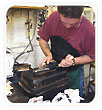 The finishing of a shoe depends on the material used for making it. If made of leather, the sole edge and heel are trimmed and buffed to give a smooth finish. To give them an attractive finish and to ensure that the edge is waterproof, they are stained, polished and waxed. The bottom of the sole is often lightly buffed, stained and polished and different types of patterns are marked on the surface to give it a craft finished look. A "finished shoe" has now been made.
The finishing of a shoe depends on the material used for making it. If made of leather, the sole edge and heel are trimmed and buffed to give a smooth finish. To give them an attractive finish and to ensure that the edge is waterproof, they are stained, polished and waxed. The bottom of the sole is often lightly buffed, stained and polished and different types of patterns are marked on the surface to give it a craft finished look. A "finished shoe" has now been made.For shoe room operation, an internal sock is fitted into shoe which can be of any length- full, half or quarter. They usually have the manufacturers details or a brand name wherever applicable. Depending on the materials used for the uppers, they are then cleaned, polished and sprayed. Laces and any tags that might have to be attached to the shoes, such as shoe care instructions, are also attached. The shoes, at last, get packaged in boxes. |
